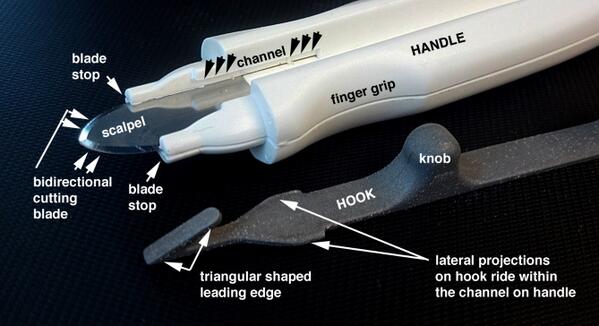
Thanks to Dr Levitan for recording and releasing the video for FOAMEd!
If you want to know more here is a Storify article by our good PHARM friend Dr Yen Chow!
[View the story “Open Cricothyrotomy (Tracheostomy) Technique” on Storify]
here a recent published article on the CricKnife and CricKey concept
The cric-key™ and cric-knife™: a combined tube-introducer and scalpel-hook open cricothyrotomy system.
Why not attend one of Richard Levitan’s world famous airway courses to see for yourself? He has taught me more about emergency airway management than any other mentor/teacher I have ever known! Skills and wisdom he taught me has allowed me to manage some horrible airway cases with confidence whilst in Outback Australia!
Here are the available courses in 2014!
Levitan Airway courses in 2014


Ditto – Levitan is a humble chap, who gave freely of time and anecdotes outside of the formal course in Sydney and at smaccGOLD, taught me the fine art of fist-bumping … as well as pure airway gold on laryngeal handshake, choo-choo nose-mouth breathing, airway psychology and technique. A good speaker. His book is well worth a read for anyone serious about airway management.
You can read a review of the Levitan Airway course (Sydney) here : http://kidocs.org/2014/03/levitan-airway-workshop/
The CricKnife worked well in cadaver session; ergonomic, easy & slick movement from skin incision to retraction of trachea.
One caveat (about which I am curious but never got time to ask) is the flexibility of the ET tube in the crick-key component- although it worked well in the cadavers, Jon Gatward pointed out that the supplied ET kinks easily – you can demo this yourself by flexing between fingers.
One might imagine that there is potential for kinking of the ET component within the trachea…that said, the mechanism of insertion is dependent upon introduction with a soft introducer as part of the CricKey (Rich – ironic that it’s more like a BOUGIE than your beloved stylets!). I think this should obviate kinkage of the supplied ET tube, but I do wonder if could be stiffer? This is of course a minor criticism and not tested.
Having had the misfortune to perform a surgical airway on five occasions over the past 15 yrs, from fiddly seldinger-technique thro’ to scalpel-finger-ETT, I think the CricKnife / CricKey system offers many advantages … it is simple kit, prepackaged, easy to train on, ergonomic and ties together key stages such as piercing CTM and retraction.
I would want one on my difficult airway trolley and in my prehospital pack.
I also think we should be teaching with this sort of kit on ATLS-EMST rather than the current yet outdated College of Surgeon’s endorsed technique of scalpel, reverse handle, ETT. But don’t get me started…
[subtle hint – any reps want to ‘loan’ me a set for teaching on airway / trauma courses here in Oz?]
Thanks for kind words and your support Tim and Minh! I love you guys too! Sydney was great fun and credit goes to John Vassiliadis and his ability to rally equipment support (especially Storz, but also others), and a great lab facility and team (Jennifer and colleagues).
Regarding tube stiffness on Cric-Key–I have brought this up with manufacturer and have been told this will be addressed in final product. Original stiffness came from tracheostomy tube, but I agree that going through the cricothyroid (and abutting cartilages above and below) it must be more resistant to kinking.
This course at Jackson Lake Lodge in the Tetons (just south of Yellowstone) is unlike any other airway course I have done. First off, its a spiritual place to be–that alone is valuable for us ED docs who I feel need to improve our beauty/death ratio…i.e., we need some recharging of the soul. It is a world heritage site, perhaps the best preserved natural habitat on the planet, filled with animals and amazing scenery. It is America’s premier national park in many respects. Yellowstone/Tetons (like Grand Canyon, Great Barrier Reef, Niagara Falls, Matterhorn) is a place that makes you smile–that feeling of you don’t want to be anywhere else in the world. Second, there will be tons of imaging (nasoendoscopy and a smorgasbord of toys). Lastly, I am molding new custom designed manikins that should be great fun.
Thanks again guys for the post!
Wow – real time feedback on comments from the inventor; that is the power of FOAMed
Yellowstone looks awesome; won’t be able to make 2014, but perhaps 2015? If nothing else, to soak in that hot tub in order to road-test the reputed waterproof capabilities of various VLs.
A pivot point for me was realising that fibreoptics, traditionally not taught to me in either EM or rural anaes training, is well within the skill set of ED. Kit is affordable now. Own the airway, indeed.
Looking after ourselves is important – whether be Yellowstone, Sydney – takign time out and engaging in spirituality as counterpoint to medicine is vital….
…so an open invite to any-and-all to visit my home on Kangaroo Island – talk airways, tax deduct and immerse yourselves in natural beauty!
Lastly – are the rumours of custom-moulded airway mannikins based on several smacc speakers true? I like the idea of a CICO scenario involving Weingart or Le Cong’s visage…
😉
Tim Leeuwenburg
Kangaroo island
@kangaroobeach
ruraldoctors.net / KIDocs.org
Yes custom moulded manikins …made of licorice 🙂
I will get you, Le Cong….. i will get you….
Cheers mate
I should add that paramedics should catch a Levitan course! Loved my time in the lab, learned quite a bit. Looking forward to being able to put CricKeys on our trucks soon. For now we’ll take Bougie-Scalpel.
Also looking forward to more smaccGold videos! (I’ll witness in person next year)